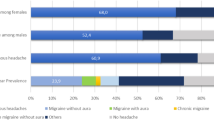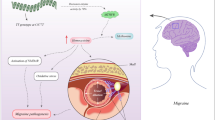Abstract
The classification of migraine includes typical headache without aura of neuro-logic deficit (previously termed common migraine; International Headache Society [IHS] classification 1.1) and headache associated with aura of neurologic deficit (previously termed classical migraine; IHS classification 1.20).1 There are other subtypes of migraine, separately categorized by specific patterns of neurologic deficit and their relation to the headache, for example hemiplegic migraine and basilar migraine.
Access this chapter
Tax calculation will be finalised at checkout
Purchases are for personal use only
Preview
Unable to display preview. Download preview PDF.
Similar content being viewed by others
References
Headache Classification Committee of the International Headache Society. Classification and diagnostic criteria for headache disorders, cranial neuralgias and facial pain. Cephalalgia 1988; 8: 27.
Stewart WF, Lipton RB, Celentano DD, Reed ML. Prevalence of migraine headache in the United States. JAMA 1992; 267: 64–69.
Rasmussen BK, Olesen J. Migraine with aura and migraine without aura: An epidemiological study. Cephalalgia 1992; 12: 221–228.
Breslau N, Davis GC. Migraine, physical health and psychiatric disorders: A prospective epidemiologic study of young adults. J Psychiatric Res 1993; 27: 211–21.
Tzourio C, Iglesias S, Hubert J-B et al. Migraine and risk of ischemic stroke: A case-controlled study. BMJ 1993; 307: 289–292.
Ottman R, Hong S, Lipton RB. Validity of family history data on severe headache and migraine. Neurology 1993; 43: 1954–1960.
Russell MB, Iselius L, Olesen J. Migraine without aura and migraine with aura are inherited disorders. Cephalalgia 1996; 16: 305–309.
Larsson B, Bille B, Pederson N. Genetic influences in headaches: A Swedish twin study. Headache 1995; 35: 513–519.
Ophoff RA, Terwindt GM, Vergouwe MN. Familial hemiplegic migraine and episodic ataxia type-2 are caused by mutations in Cat+ channel gene CACNLA4. Cell Tissue Res 1996; 87: 543–552.
Leao AAP. Spreading depression of activity in cerebral cortex. J Neurophysiol 1944; 7: 379–390.
Graftstein B. Mechanism of spreading cortical depression. J Neurophysiol 1956; 19: 154–17.
Van Harreveld A. The nature of the chick’s magnesium-sensitive retinal spreading depression. J Neurobiol 1984; 15: 333–344.
Van Harreveld A. Two mechanisms for spreading depression in the chicken retina. J Neurobiol 1978; 9: 419–431.
Van Harreveld A, Reuter JH. The dual effect of L-proline on spreading depression in the chicken retina. Neurosci Lett 1981; 23: 329–332.
Lashley K. Patterns of cerebral integration indicated by the scotomas of migraine. Arch Neurol Psych 1941; 46: 333–339.
Milner PM. Note on a possible correspondence between scotomas of migraine and spreading depression of Leao. Electroencephalogr Clin Neurophysiol 1958; 910: 705.
Lauritzen M, Olsen TS, Lassen NA, Paulson OB. The role of spreading depression in acute brain disorders. Ann Neurol 1983; 14: 569–572.
Welch KMA, Cao Y, Aurora S, Vikingstad E. Functional MRI (fMRI) of visually triggered headache: Stimulation, suppression and propagation of the BOLD effect. Neurology 1997; 48: A85.
Barkley GL, Tepley N, Simkins R, Moran J, Welch KMA. Neuromagnetic fields in migraine: Preliminary findings. Cephalalgia 1990; 10: 171–176.
Moskowitz MA. The neurobiology of vascular head pain. Ann Neurol 1984; 16: 157–168.
Goadsby PJ, Edvinsson L, Ekman R. Release of vasoactive peptides in the extracerebral circulation of men and the cat during activation of the trigeminovascular system. Ann Neurol1988; 23: 193–196.
Goadsby PJ, Edvinsson L. Sumatriptan reverses the changes in calcitonin gene-related peptide seen in the headache phase of migraine. Cephalalgia 1991; 11: (Suppl 11): 3.
Weiller C, May A, Limmroth V, Juptner M, Kaube H, van Schayck R, Coenen HH, Diener HC. Brainstem activation in human migraine attacks. Nature Medicine 1995; 1: 658–660.
Moskowitz MA, Nozaki K, Kraig R. Neocortical spreading depression provokes the expression of c-fos protein-like immunoreactivity within trigeminal nucleus caudalis via trigeminovascular mechanisms. J Neuro 1993; 13: 1167–1177.
Olesen J, Andersen AR, Hedman C. Sense of separating classic and common migraine. In: Ferrari MD, LaVaste X, eds. Migraine and Other Headaches. 1989x39–144.
Woods RP, Iacoboni M, Mazziotta JC. Bilateral spreading cerebral hypoperfusion during spontaneous migraine headache. New Engl J Med 1994; 331: 1689–1692.
Welch KMA, Ramadan NM. Mitochondria, magnesium and migraine. J Neurol Sci 1995; 134: 9–14.
Welch KMA, Tepley N, Barkley G, Ramadan NM. The concept of migraine as a state of central neuronal hyperexcitability. Neurol Clin 1990; 8: 817–828.
Wray SH, Mijovic-Prelec D, Kosslyn SM. Visual processing in migraineurs. Brain 1995; 118: 25–35.
Diener HC, Scholz E, Dichgans J, Gerber WD, Jack A, Bille A, Niederberger U. Central effects of drugs used in migraine prophylaxis evaluated by visual evoked potentials. Ann Neurol 1989; 25: 125–130.
Benna P, Bianco CP, Piazza D, Bergamasco B. Visual evoked potentials and brainstem auditory evoked potentials in migraine and transient ischemic attack. Cephalalgia 1985; 2 (Suppl): 53–58.
Noordhout MD, Pepin JL, Schoenen J, Delwaide PJ. Percutaneous magnetic stimulation of the motor cortex in migraine. Electroencephalogr Clin Neurophysiol 1992; 85: 110–115.
vanderKamp W, Maassenvandenbrink A, Ferrari MD, van Dijk JG. Interictal cortical hyperexcitability in migraine patients demonstrated with transcranial magnetic stimulation. J Neurol Sci 1996; 139: 106–10.
Aurora SK, Ahmad BK, Welch KMA, Bhardhwaj P, Ramadan NM. Transcranial magnetic stimulation confirms hyperexcitability of occipital cortex in migraine. Headache 1997; (in press).
Rowland LP. Molecular genetics, pseudogenetics and clinical neurology. The Robert Warternberg Lecture. Neurology 1983; 33: 1189–1195.
Dvorkin GS, Anderman F, Carpenter S. Classical migraine, intractable epilepsy and multiple strokes: A syndrome related to mitochondrial encephalomyopathy. In: Anderman F, Lugaresi E, eds. Migraine and epilepsy. Boston: Butterworths, 1987: 203–232.
Mosewich RK, Donat JR, DiMauro S, Ciafaloni E, Shanske S, Erasmus M, George D. The syndrome of mitochondrial encephalomyopathy, lactic acidosis, and stroke-like episodes presenting without stroke. Arch Neurol 1993; 50: 275–278.
Montagna P, Gallassi R, Medori R, Govoni E, Zeviani M, DiMauro S et al. MELAS syndrome: Characteristic migrainous and epileptic features and maternal transmission. Neurology 1986; 38: 751–4.
Bresolin N, Martinelli P, Barbirolli B, Zaniol P, Ausenda C, Montagna P, Gallanti A, Comi GP, Scarlato G, Lugaresi E. Muscle mitochondrial DNA deletion and j1P NMR spectroscopy alterations in migraine patient. J Neurol Sci 1991; 104: 182–189.
Shimomura T, Kitano A, Marukawa H, Takahashi K. Mutation in platelet mitochondrial gene in patients with migraine. Proceedings of the 7th International Headache Congress 1995; 15: 1o.
Klopstock T, May A, Seibel P, Papagiannuli E, Diener HC, Reichman H. Mitochondrial DNA in migraine with aura. Neurology 1996; 46: 1735–1738.
Welch KMA, Levine SR, D’Andrea G, Schultz LR, Helpern JA. Preliminary observations on brain energy metabolism in migraine studied by in-vivo phosphorous 31 NMR spectroscopy. Neurology 1989; 39: 538–541.
Barbirolli B, Montagna P, Cortelli P, Fanicello R, Iotti S, Munari L, Pierangeli G, Zaniol P, Lugaresi E. Abnormal brain and muscle energy metabolism shown by j1P magnetic resonance spectroscopy in patients affected by migraine with aura. Neurology 1992; 42: 1209–1214.
Uncini A, Lodi R, Dimuzio A, Silvestri G, Lugaresi A, Iotti S, Zaniol P, Barbirolli B. Abnormal brain and energy metabolism in familial hemiplegic migraine. J Neurol Sci 1995; 129: 214–222.
Barbiroli B, Montagna P, Cortelli P, Martinelli P, Sacquegna T, Zaniol P, Lugaresi E. Complicated migraine studied by phosphorus magnetic resonance spectroscopy. Cephalalgia 1990; 10: 263–272.
Gunther T. Biochemistry and pathobiochemistry of Mg. Mag Bull 1981; 3: 91–101.
Grubbs RD, Maguire ME. Magnesium as a regulatory cation: Criteria and evaluation. Magnesium 1987; 6: 113–127.
Chutkow JG. The neurophysiologic function of magnesium: An update. Mag Bull 1981; la:u-20.
Ramadan NM, Halvorson H, Vande-Linde AMQ, Levine SR, Helpern JA, Welch KMA. Low brain magnesium in migraine. Headache 1989; 29: 590–593.
Barker PB, Boska MD, Butterworth EJ, Hearshen D, Aurora TK, Norris L, Duyn JH, Moonen CTW, Welch KMA. Phosphorus and proton MR spectroscopic imaging in migraine. Proc Soc Magn Res 1995; 1: 139.
Baudrimont M, Dubas F, Joutel A, Tournier-Lasserve E, Bousser MG. Autosomal dominant leukoencephalopathy and subcortical ischemic stroke: A clinicopathological study. Stroke 1993; 24: 122–125.
Joutel A, Bousser M-G, Biousse V, Labauge P, Chabriat H, Nibbio A, Macizzek J, Meyer B, Bach M-A, Weissenbach J, Lathrop GM, Tournier-Lasserve E. A gene for familial hemiplegic migraine maps to chromosome 19. Nature Genetics 1993; 5: 40–45.
Joutel A, Corpechot C, Ducros A, Vahedi K, Chabriat H, Mouton P, Alamowitch S, Domenga V, Cecillion M, Marechal E, Maciazek J, Vayssiere C Cruaud C, Cabanis EA, Ruchoux MM, Weissenbach J, Bach JF, Bousser MG, TournierLasserve E. Notch 3 mutations in CADASIL, a hereditary adult-onset condition causing stroke and dementia. Nature 1996; 383: 707–710.
Cogdignola A, Tarroni P, Clementi F, Polio A, Lovallo M, Carbone E, Sher E. Calcium channel subtypes controlling serotonin release from human small cell lung carcinoma cell lines. J Biol Chem 1993; 268: 26240–26247.
May A, Ophoff RA, Terwindt GM, Urban C, van Eijk R, Haan J, Diener HC, Lindhout D, Frants RR, Lodewijk AS, Ferrari MD. Familial hemiplegic migraine locus on 19p13 is involved in the common forms of migraine with and without aura. Hum Genet 1995; 96: 604–608.
Merikangas KR. Genetics of migraine and other headache. Curr Opin Neurol 1996; 9 (3): 202–205.
Editor information
Editors and Affiliations
Rights and permissions
Copyright information
© 1998 Springer-Verlag Berlin Heidelberg
About this chapter
Cite this chapter
Welch, K.M.A., Flippen, C. (1998). Mitochondrial Disorder and Migraine. In: Singh, K.K. (eds) Mitochondrial DNA Mutations in Aging, Disease and Cancer. Springer, Berlin, Heidelberg. https://doi.org/10.1007/978-3-662-12509-0_19
Download citation
DOI: https://doi.org/10.1007/978-3-662-12509-0_19
Publisher Name: Springer, Berlin, Heidelberg
Print ISBN: 978-3-662-12511-3
Online ISBN: 978-3-662-12509-0
eBook Packages: Springer Book Archive




